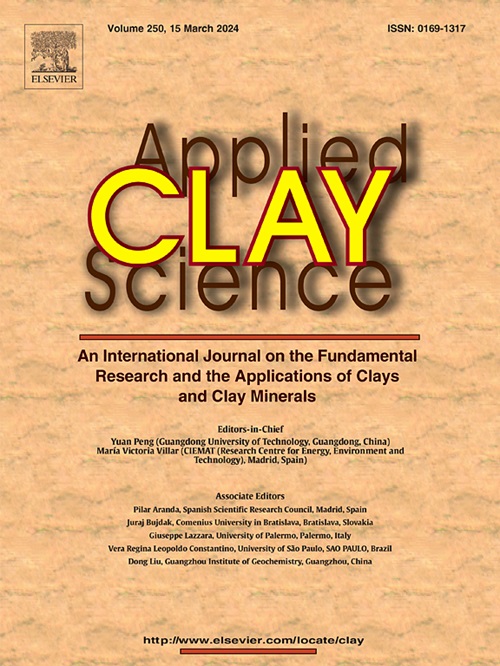铁对膨润土稳定性影响的研究进展
IF 5.3
2区 地球科学
Q2 CHEMISTRY, PHYSICAL
引用次数: 0
摘要
高放射性废物(HLW)储存库可能包括铁或钢基容器/包和膨润土缓冲层。在过去的大约25年里,研究人员试图阐明铁-膨润土相互作用的性质,特别是膨胀粘土成分(蒙脱石)的潜力,这些成分可能会转变为富含铁的粘土矿物,而这些粘土矿物可能缺乏晶内膨胀。这可以降低膨润土缓冲液中的膨胀压力,膨润土缓冲液旨在保护废物容器免受剪切力的影响,并限制水和溶质的运输。铁-膨润土相互作用的大多数数据来自实验和地球化学模拟研究,因为缺乏自然模拟数据。这些数据表明,在原生蒙脱石(蒙脱石)转变为富铁固体(包括粘土矿物和典型的钢铁腐蚀产物,如“绿锈”或磁铁矿(Fe3O4)的过程中,有发展富铁膨润土蚀变带的潜力。现有的证据是复杂的,有许多潜在的复杂耦合。尽管经过多年的努力,不确定性仍然存在,但铁-膨润土相互作用的合理情况已经确定,并提出了缓冲性能的影响。进一步阐明铁-膨润土相互作用的未来工作可以集中在验证富铁粘土的热力学数据,探索蚀变膨润土的输运和工程性质,开发更先进的反应输运模型,包括多相现象,以及更现实的膨润土孔隙水表示方法。本文章由计算机程序翻译,如有差异,请以英文原文为准。
A review on the effect of iron on bentonite stability
High-Level Radioactive Waste (HLW) repositories may include iron or steel-based containers/overpack and bentonite buffers. Over the last approximately 25 years, research efforts have attempted to elucidate the nature of iron-bentonite interactions, especially the potential for the swelling clay component (smectite), to undergo alteration to iron-rich clay minerals which may lack intracrystalline swelling. This could reduce swelling pressure in the bentonite buffer which is intended to protect waste containers from shear forces and restrict water and solute transport. Most data on iron-bentonite interactions come from experimental and geochemical modelling studies, as natural analogue data are lacking. The data suggests that there is the potential for the development of an iron-rich bentonite alteration zone with primary smectite (montmorillonite) undergoing alteration to iron-rich solids, including clay minerals and typical steel corrosion products such as “green rust” or magnetite (Fe3O4). The evidence available is complex with many potential complex couplings. Uncertainties remain despite efforts taken over many years, but plausible scenarios for iron-bentonite interactions have been identified and implications for buffer properties have been suggested. Future efforts to further elucidate iron-bentonite interactions could focus on validating thermodynamic data for iron-rich clays, exploring the transport and engineering properties of altered bentonite, and developing more advanced reactive-transport models that include multi-phase phenomena, and a more realistic approach to bentonite porewater representation.
求助全文
通过发布文献求助,成功后即可免费获取论文全文。
去求助
来源期刊

Applied Clay Science
地学-矿物学
CiteScore
10.30
自引率
10.70%
发文量
289
审稿时长
39 days
期刊介绍:
Applied Clay Science aims to be an international journal attracting high quality scientific papers on clays and clay minerals, including research papers, reviews, and technical notes. The journal covers typical subjects of Fundamental and Applied Clay Science such as:
• Synthesis and purification
• Structural, crystallographic and mineralogical properties of clays and clay minerals
• Thermal properties of clays and clay minerals
• Physico-chemical properties including i) surface and interface properties; ii) thermodynamic properties; iii) mechanical properties
• Interaction with water, with polar and apolar molecules
• Colloidal properties and rheology
• Adsorption, Intercalation, Ionic exchange
• Genesis and deposits of clay minerals
• Geology and geochemistry of clays
• Modification of clays and clay minerals properties by thermal and physical treatments
• Modification by chemical treatments with organic and inorganic molecules(organoclays, pillared clays)
• Modification by biological microorganisms. etc...
 求助内容:
求助内容: 应助结果提醒方式:
应助结果提醒方式:


